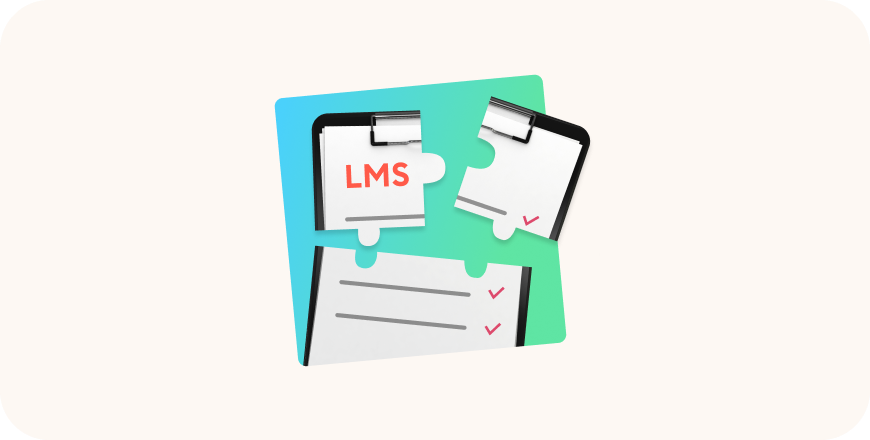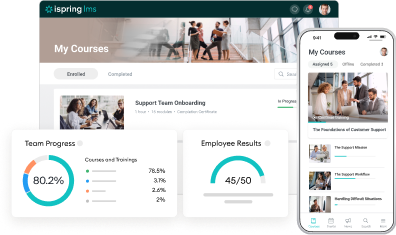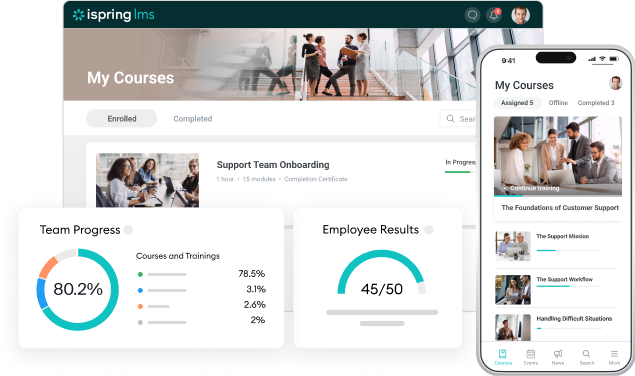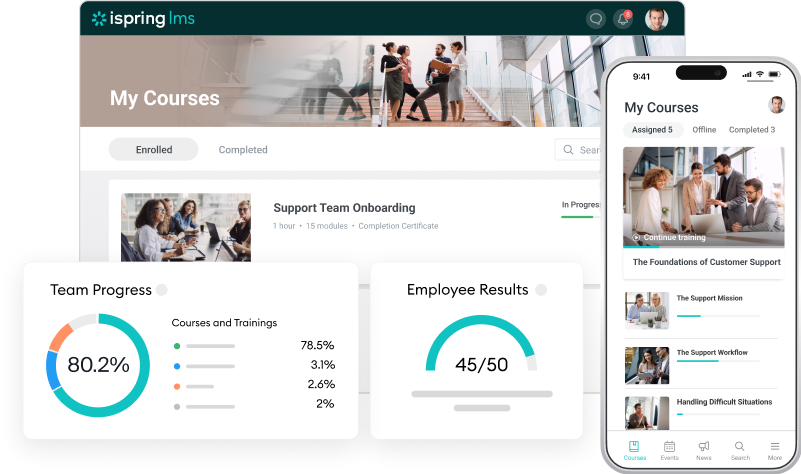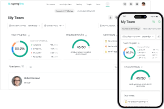What Is an LMS? Definition, Benefits, and Use Cases
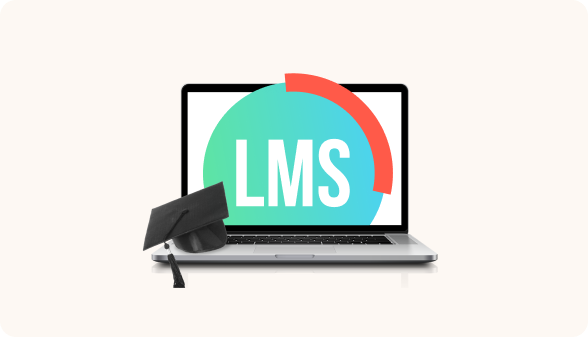
If you’re running employee training, onboarding new hires, or managing compliance deadlines, chances are you’re either using a learning management system or thinking about doing so.
Modern learning solutions on the LMS market have evolved from file storage tools to smart platforms that help L&D teams personalize learning, automate delivery, and align training with business goals.
In this guide, we’ll cover the basics of learning management systems, including what LMSs are, their use cases, key benefits to businesses, core functionalities, latest trends, and how to choose the LMS that will support your goals.
What Is a Learning Management System (LMS)?
A learning management system or LMS is software that helps you organize, deliver, and track online training. This is a centralized place where employees or students can complete courses, quizzes, and track their progress, while admins manage users, automate assignments, and get clear reports on learning outcomes.
How does an LMS work?
At its core, an LMS follows a simple flow:
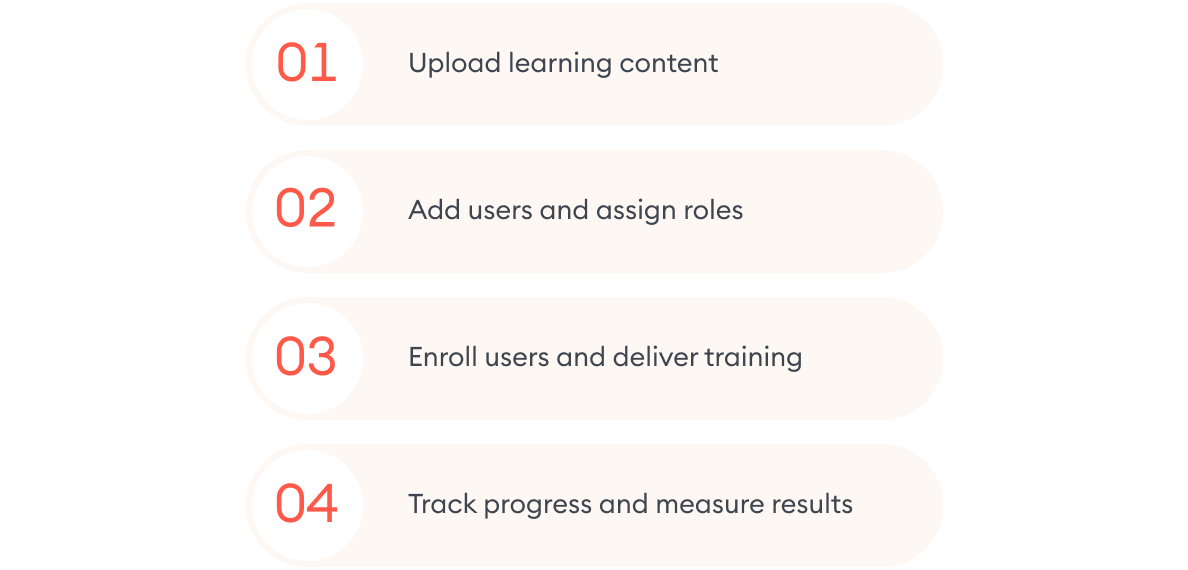
- Upload or create content. SCORM (Sharable Content Object Reference Model) packages, PDFs, videos, presentations, podcasts, and quizzes. Some advanced LMSs also let you build content directly inside the platform.
- Add users and assign roles. This can be done manually, via import, or through integrations with HR systems. The key roles include learners (who take online courses), LMS admins (who manage the platform), and instructors (who review results and give feedback.)
- Enroll users and deliver training. Once everything’s set up, you can assign course materials to users either manually or automatically, based on rules or roles. Learners get access via desktop or mobile and can complete training at their own pace or by a deadline.
- Track learner progress and measure results. Admins can monitor learner activity: course completions, quiz scores, time spent, and certifications earned. You can generate detailed reports, identify skill gaps, and use the data to improve your training strategy.
The Main Types of Learning Management Systems
Most platforms handle course management and tracking. What sets them apart is how they’re hosted, how they scale, and how they support content standards. These technical choices affect your flexibility, costs, and overall fit with your operations.

Hosting models: cloud-based vs. self-hosted
The hosting model determines who owns the infrastructure — and who’s responsible for maintaining it.
Cloud-based LMSs are hosted and managed by the vendor. They’re quick to deploy, require little to no IT involvement, and benefit from automatic updates. For most organizations, especially those prioritizing speed, scalability, and operational efficiency, the SaaS LMS (software as a service) is the go-to model.
An on-premise or self-hosted LMS is deployed on your servers and managed internally. This model offers maximum control over data and customization, a key factor in highly regulated or security-conscious environments, but comes with greater IT overhead and longer implementation timelines.
With platforms like iSpring LMS, you can choose the deployment model that best fits your organization’s infrastructure, security standards, and strategic priorities.
Pricing models: open-source vs. commercial
How a learning management system (LMS) is priced has a direct impact on long-term usability, scalability, and the internal training resources required to manage it.
Open-source LMSs like Moodle are free to use but often come with hidden costs. Setup, customization, security, and support all fall on your internal team or external contractors.
Commercial LMSs come with built-in technical support, regular updates, and faster time to value. Within this category, you’ll typically find:
- Pay-per-user / active user models (those who access the platform per month)
- Flat-rate subscription plans, often billed annually and tiered by feature set, user volume, or support level.
- License-based models — onetime fees for perpetual use, more common in legacy or government procurement scenarios.

Content compatibility: SCORM, xAPI, and beyond
eLearning content formats directly influence how you design, deliver, and track learning.
SCORM (both 1.2 and 2004) remains the most widely used and supported standard across LMS platforms, making it the safest choice for teams that want to build reusable, trackable content. xAPI (formerly Tin Can) enables more flexible and granular tracking, capturing learning experiences across systems and beyond a learning management system (LMS).
AICC, although outdated, is still required in some compliance-heavy industries. cmi5 is an emerging spec designed to combine the structure of SCORM with the flexibility of xAPI, though its adoption is still in the early stages.
Who Uses an LMS?
Different types of learning management systems serve a wide range of users from global enterprises to solo course creators. While their goals may differ, they all use LMS technology to create scalable, structured, and trackable learning experiences.
Corporate sector
In companies, LMSs support an internal training strategy. In large organizations, LMS software helps deliver consistent employee training across regions, roles, and job levels. L&D professionals also rely on LMSs to report on performance, identify skill gaps, and automate learning paths tied to career progression.
When integrated with HR systems or performance platforms, an LMS becomes a part of a broader corporate ecosystem that supports skills development and employee retention.


Educational institutions
In higher education institutions and K–12 environments, LMSs provide structure for hybrid and fully online learning experiences. They allow institutions to manage content delivery, assessments, student engagement, and grading.
For academic leadership, a learning management system (LMS) also supports curriculum consistency, learning environment accessibility, instructor-led training, and accreditation tracking. It becomes the digital infrastructure behind modern pedagogy, enabling flipped classroom management, adaptive testing, and scalable feedback loops.


Entrepreneurs and content creators
Independent trainers, coaches, and edupreneurs use LMSs to deliver polished, branded learning products at scale, without the need for a tech team. For content creators, an LMS is a core part of their offering — enabling them to monetize their expertise and manage learning communities.
Nonprofits and government
Public sector institutions often need to train large, distributed teams with limited resources, making the LMS a critical enabler of reach and consistency. Whether it’s onboarding volunteers, upskilling field staff, or launching public awareness campaigns, an LMS ensures that knowledge is delivered in a structured, measurable way.


Common LMS Use Cases Across Industries
While learning goals vary by company size, sector, and culture, the core use cases for LMSs remain remarkably consistent. Below are the most common (and business-critical) ways that organizations use learning management systems today:
New employee onboarding
With LMS software, organizations can automate and standardize new employee onboarding across roles and locations, ensuring that every new hire receives the same high-quality, role-specific training. An LMS supports onboarding processes as a continuous learning journey, combining compliance, culture, and new skill development into structured learning paths that reduce ramp-up time and increase employee retention.
Compliance training
Industries like healthcare, finance, manufacturing, and logistics rely on LMSs to deliver, document, and audit compliance training. With due dates, completion tracking, and certification, LMSs help organizations mitigate risk and ensure adherence to compliance standards. For L&D leaders, compliance training software provides more insights into who’s compliant, who’s overdue, and where knowledge gaps exist.
Product and sales training
In-depth product knowledge training empowers customer-facing teams to confidently communicate value, navigate objections, and align features with client-specific outcomes. With contextual, just-in-time learning delivered through an LMS, organizations can keep teams aligned amid expanding product lines, evolving positioning, customer profiles, and continuous updates.
Partner and customer training
Extending the learning process beyond the organization is a growing use case, especially for companies with channel partners, resellers, or enterprise customers. LMSs enable organizations to create branded learning portals that provide just-in-time member training, partner and customer training, reduce support costs, and deepen product adoption.
Leadership and professional development
As skill needs change faster (and external hiring gets more expensive), companies are rethinking how they can spot potential and support internal mobility.
L&D teams use the learning management system software to guide people through role transitions, identify stretch assignments, and make professional development part of everyday work. Paired with performance and talent data, soft skills and leadership training via LMS software becomes a strategic lever for long-term capability growth across the organization.
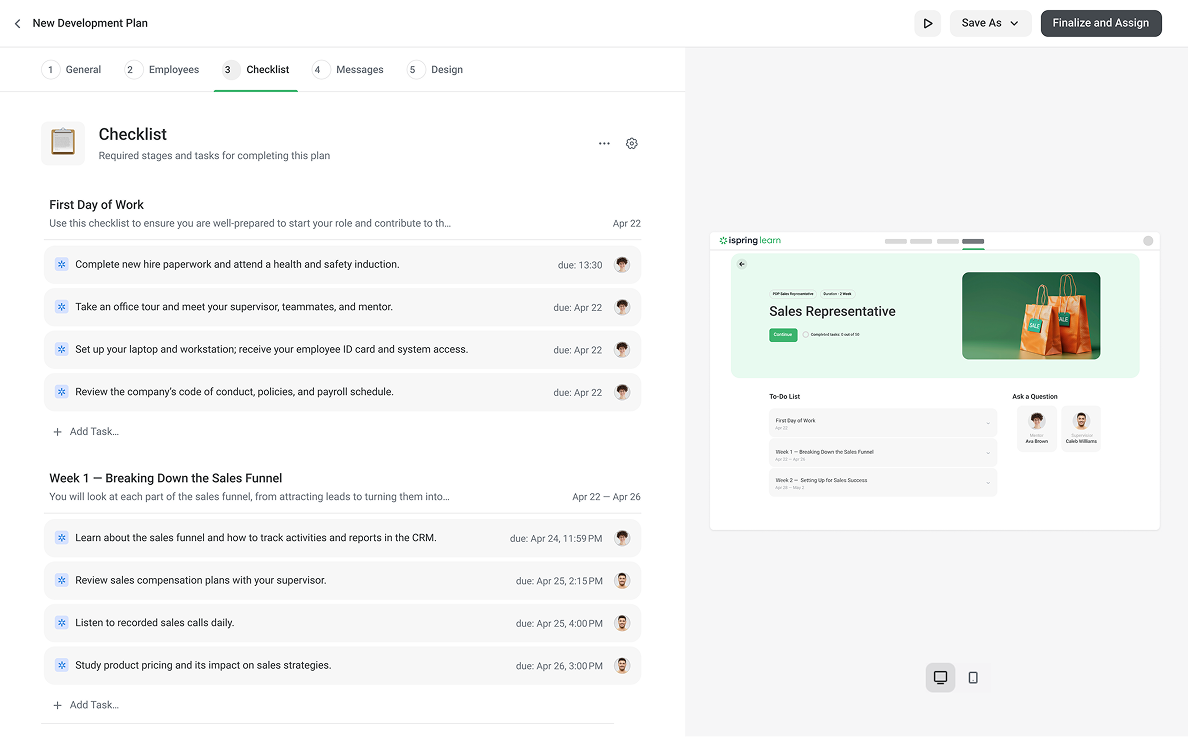
In iSpring LMS, team leads and L&D managers can create personalized learning experiences with essential milestones and required training, making career progression more transparent.
Why Use a Learning Management System? 5 LMS Benefits.
LMSs are becoming a core part of organizational infrastructure, alongside CRMs, HRIS platforms, and collaboration tools. When used strategically, they reduce friction in daily operations, generate measurable impact, and support long-term capability growth. Here are five arenas in which companies are leveraging an LMS:
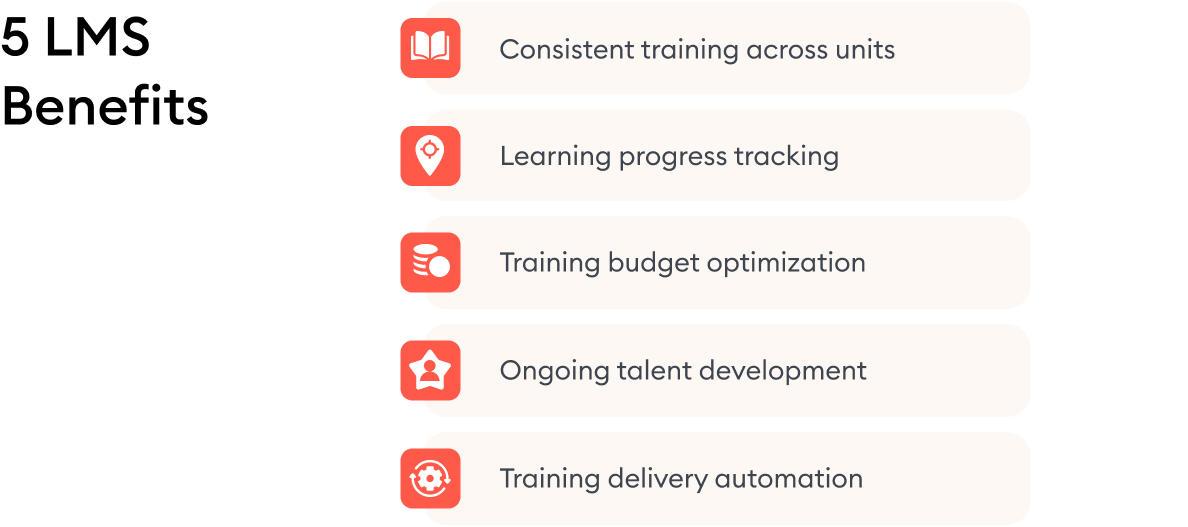
Consistent training across units
Whether you’re onboarding new hires, rolling out compliance updates, or delivering product knowledge, consistency is one of the main LMS benefits, especially in distributed or fast-growing organizations.
An LMS allows you to create structured learning programs and deliver them across teams, departments, and locations. This eliminates knowledge silos and ensures that every learner, from a field technician to a regional manager, receives the same high-quality training experience.
In iSpring LMS, for example, beyond course delivery, you can also create an internal knowledge base with dedicated spaces, folders, and role-based permissions. This makes it easy to centralize critical content and ensure that everyone is working from the same source of truth.
Training budget optimization
One of the most immediate ways an LMS improves cost-efficiency is by shifting the learning process from face-to-face to online programs. That means lower employee training costs on venues, travel, printed training materials, and facilitator time (typical for in-person learning), especially for organizations with distributed teams or high onboarding volumes.
But for L&D leaders, the bigger value lies in operational scalability. Once a course is built, it can be reused, localized, and delivered across business units without additional delivery costs. Over time, this creates a more sustainable training model: fewer spikes in spend, fewer dependencies on external vendors, and better control over long-term resource allocation.
Training delivery automation
Assigning online courses, sending reminders, and tracking completions are critical, but they shouldn’t require hands-on oversight. That’s why LMSs like iSpring LMS facilitate learning: new hires automatically receive onboarding paths based on their role or department, compliance modules are reassigned on schedule, and overdue learners are nudged without L&D intervention.
Automated training creates space for strategic work. Instead of chasing completions or building reports, your L&D team can focus on improving content, analyzing student learning impact, and aligning programs with business needs.
Learning progress tracking
An LMS makes learning activity visible at every level, from individual completions to team-level trends and organizational readiness. With dozens of built-in LMS reports, it’s easy to surface meaningful insights: who’s falling behind, where learners drop off, which courses underperform, and where to focus your attention next.

Beyond its 25+ ready-made reports, iSpring LMS also offers a dedicated LMS dashboard, giving managers real-time visibility into user progress.
Ongoing talent development
A learning management system enables structured, ongoing development that aligns with business strategy and future workforce needs. For L&D teams, this means moving beyond isolated training programs and toward role-based learning paths, leadership pipelines, and skill progression frameworks.
LMS Features: Key Capabilities of a Modern Platform
Choosing the right learning platform means balancing must-have functionality with advanced capabilities that support long-term goals.
Below, we break down LMS features into two groups: core functions that every system typically provides, and advanced tools that set leading platforms apart.
Core functionality
These are the essential features that almost every platform offers and that your team likely depends on daily:
- Training management. You should be able to upload content in various formats, organize it into modules or learning paths, and assign it based on job role, department, or location.
- User management. An LMS allows you to segment people into groups, assign access rights, automate enrollments, and mirror your org structure inside the platform.
- Training automation. This includes enrolling learners in the right training programs, sending reminders, assigning follow-up content, and issuing certificates, all based on rules that you define.
- Reporting capabilities. You should be able to monitor course completion rates, time spent, and assessment results across individuals, groups, and courses, with reports that are easy to filter and export.
Advanced capabilities
Advanced solutions also feature LMS modules that enable business agility, operational scale, and student performance alignment. Top-rated LMSs often include:
- Content creation tools. Some platforms, like iSpring LMS, offer built-in content authoring so you can create interactive, media-rich courses right inside the LMS, without third-party digital tools.
- Mobile learning with offline support. This allows field teams, frontline employees, and traveling staff to access learning anytime, anywhere. Employees can download learning materials in the cloud-based LMS, train on the go, and sync their results later.
- Performance appraisal. Advanced learning management system software helps close the loop between training and real-world performance: set development goals, run evaluations, and track student progress over time.
- Built-in knowledge base. A centralized knowledge hub helps employees find quick answers, job aids, and SOPs right when they need them without separate wikis.
- Custom analytics and dashboards. Pre-built reports give you the basics, but when you’re looking to answer more nuanced questions, you’ll need custom dashboards to extract specific data that’s essential for your needs but not typically provided by default.
- White labeling. This includes customizing the LMS interface: logo, color palette, domain name, and, in some cases, even the learner-facing app on mobile devices. Highly customizable platforms help reinforce brand identity and trust, especially in customer or partner training scenarios.
- Integrations. Seamless LMS integration with HRIS, CRM, analytics, video conferencing, messaging, and other tools help streamline training workflows, automate user management, and reduce duplicated data entry.
3 Steps to Choose the Right Learning Platform for Your Business
The best LMS isn’t the one with the longest feature list. To choose an LMS that fits your learning goals, internal workflows, and available resources, consider these three steps:
Step 1. Identify your organization’s goals
Instead of broad goals like “improve training,” ask more focused questions: What problems are we solving? Are we trying to standardize learning across locations? Speed up new hire ramp-up? Lower compliance risks? Help people grow into new roles?
Once you answer these questions, it’s easier to see what kind of learning management system software you actually need — and in some cases, you may realize that an LMS isn’t the entire solution.
Your answers will guide everything: which features matter most, how the system should be set up, what integrations you’ll need, and how you’ll build your educational content. For example, a tool that’s great for onboarding might not work well for external certifications.
Step 2. Define key criteria and limitations
Think about your budget, internal capacity, technical expertise, and existing systems. If you’ve only got one admin, automation and smart user management become essential. If your HR tools are all over the place, look for strong integrations and SSO (Single Sign On).
Also consider ownership: Who will run the LMS daily? Will teams manage their own content? These choices shape how reports, roles, and permissions will work.

Step 3. Research and shortlist options
Once you’ve mapped your goals and constraints, start testing. Don’t rely solely on feature lists or vendor promises. Instead, request live demos that are tailored to your specific use case. Bring actual scenarios: onboarding flows, compliance training, and manager dashboards. Ask vendors to walk you through how their system would handle your specific needs.

Also, most LMSs offer free trials. Set up a small training flow, test automation rules, assign content, and preview reporting. Loop in actual LMS users — especially team leads or regional managers — to get feedback early on.
For a more consistent LMS selection process, download our free guide, How to Select an LMS. Inside, you’ll find a comprehensive LMS buyer’s guide, an LMS request for proposal template, and a collection of essential checklists.
The Top 5 LMS Trends Shaping 2025-2026
AI-powered learning experiences
Artificial Intelligence is now built into many tools. In LMSs, it helps L&D draft course content, generate visuals, and translate employee training materials in minutes. While most current use cases focus on speeding up content development, we’re now seeing early adoption of AI for learner support, content recommendations, and behavioral insights inside LMSs. In the next few years, AI features will become an integral part of core LMS workflows.
Data-driven learning strategy
The bar for analytics is getting higher. Organizations want to forecast readiness, spot risk early, and make learning decisions that are backed by evidence.
That’s why enterprise LMSs are starting to develop beyond static reports toward more predictive insights: identifying which teams are likely to miss a compliance deadline based on past patterns or surfacing employees at risk of early churn due to disengagement resulting from their onboarding experience.
Focus on skill and talent development
As upskilling and internal mobility become strategic priorities, LMSs are increasingly tied to career pathing and talent planning. Many teams now connect learning activities to skill frameworks, development plans, and performance reviews, improving retention. Some LMSs now support skill tagging, tracking growth over time, and even visualizing talent pools.
Collaborative and social learning
Peer learning is gaining traction as a way to scale internal knowledge and keep learners engaged. LMSs are beginning to support interactive features like discussion forums (discussion boards), peer feedback, user-generated content, and integrated communities that create immersive learning experiences.
These collaborative learning tools are especially valuable for remote learning, distributed teams, expert-driven organizations, and roles where experience matters as much as formal learning and training.
Mobile-first learning
In industries like retail, logistics, and healthcare, learning has to fit within real-world constraints, e.g., short windows, shared devices, and poor connectivity. That’s why mobile LMSs are seeing stronger adoption. Platforms with robust mobile apps (including offline access, push notifications, and a responsive UX) are far better equipped to deliver content at the point of need.
FAQ
1. What is the difference between an LMS, an LCMS, and an LXP?
An LMS is mainly used to deliver and manage courses. The LCMS (learning content management system), on the other hand, is built for creating and organizing learning content — especially when you need to reuse materials across different courses or formats. An LXP (learning experience platform) is more learner-driven: it recommends content based on user behavior, encourages self-paced discovery, and often includes social learning features.

2. How much does LMS implementation cost?
It varies greatly. Some platforms charge per user, while others offer flat rates. Open-source tools might be free upfront, but come with extra costs for setup, support, and hosting. The total cost depends on your needs — like integrations, content migration, and admin training.

3. How do I measure LMS ROI?
ROI shows up where learning meets business results. That could be faster onboarding, fewer compliance gaps, better team performance, or reduced churn. The clearer the link between your LMS data and business KPIs, the easier it is to prove value. To learn more, explore our guide on how to calculate LMS ROI.
Get Started with iSpring LMS
If you’re ready to explore LMS options, feel free to start with iSpring LMS. Book a free consultation with one of our eLearning experts to:
- Get a tailored training solution designed around your training needs and objectives.
- See exactly how our LMS can support your training goals.
- Ask questions about launching, delivering, and optimizing your training initiatives.
